To Heat or Not to Heat: A Raw Milk Yogurt Question
Raw milk’s versatility is one of its many benefits. You can drink it straight out of a glass or use it to make other dairy products like butter, cheese, and yogurt.

One of our favorite things to make with raw milk from our Jersey milk cows is yogurt. Not only is it healthier1 for us but it also makes for a fun family activity.
We follow a raw milk recipe to make our yogurt that includes just 4 steps. It’s so easy that even young children can help with the task.
One of the steps includes pasteurizing the raw milk using a heating process at home. However, this step is optional. Our family doesn’t pasteurize because we’re confident we follow best practices for caring for our cows and during the milking process, so we always skip this part of the recipe.
To help you decide whether heating or not heating is the right choice for your family, let’s discuss the pros and cons of each, plus answer the following questions:
- How does pasteurization affect raw milk?
- What are the pros and cons of pasteurizing raw milk?
- How do beneficial bacteria in raw milk contribute to yogurt fermentation?
- How does raw milk impact the flavor and texture of yogurt?
- What are the nutritional benefits of using raw milk in yogurt?
How does pasteurization affect raw milk?
Pasteurization2 is a heat-treatment process designed to eliminate or reduce harmful microorganisms – bacteria, parasites, viruses – from food and beverages.
When applied to raw milk, pasteurization has several effects.
Enzyme activation
Pasteurization inactivates certain enzymes present in raw milk to extend its shelf life. One of the most beneficial enzymes destroyed during this heating process is called Alkaline Phosphatase3 (ALP).
ALP’s main function is to break down proteins in your body. It helps fight off bad bacteria in your gut, which can aid in better digestion. For this reason, people with leaky gut syndrome4 and other digestive issues may prefer yogurt made from raw milk.
Microbial reduction
The primary purpose of pasteurization is to reduce the microbial load in raw milk. By heating the milk to at least 150 degrees Fahrenheit for 30 minutes, the theory is that harmful pathogens are killed or significantly reduced.
The U.S. Food and Drug Administration (FDA) requires pasteurization for all milk sold in interstate commerce5.
However, as we previously mentioned, heating raw milk to such high temperatures can kill beneficial enzymes and nutrients.
What are the pros and cons of pasteurizing raw milk?
It’s OK to want to know the advantages and disadvantages of pasteurizing your raw milk before turning it into homemade yogurt. We certainly understand the hesitation if you’ve never consumed raw milk before.
According to the FDA, the following are the pros of milk pasteurization:
- Elimination of pathogens. This is the number one reason the FDA recommends pasteurization for all raw milk. When heated to at least 150 degrees Fahrenheit for 30 minutes, any bacteria, parasites, or viruses present in raw milk are destroyed or significantly reduced.
- Extended shelf life. Pasteurizing raw milk extends the shelf life by preventing the growth of microorganisms that can cause spoilage.
- Safety assurance. Pasteurization is a widely accepted method for eliminating harmful microorganisms and extending the shelf life of raw milk. The FDA states this safety assurance makes consumers more confident in buying and drinking milk.
Pasteurization may boost safety in some instances, but it also has cons. One of the biggest disadvantages is the loss of beneficial organisms, enzymes, and probiotics found naturally in raw milk. It’s our primary reason for not pasteurizing our Jersey milk cow’s raw milk before consuming it.
Another pro of drinking raw milk or using it to make homemade yogurt is the flavor and texture you get from milk that’s not pasteurized. Raw milk – especially from Jersey milk cows – is rich and creamy. Pasteurization can reduce the overall creaminess, which means your yogurt loses some flavor and texture.
How do beneficial bacteria in raw milk contribute to yogurt fermentation?
Beneficial bacteria play an important role in the process of yogurt fermentation. They transform raw milk into creamy and tangy yogurt.
The primary bacteria responsible for this transformation is lactic acid6. Two of the most common strains of lactic acid are Lactobacillus bulgaricus and Streptococcus thermophilus.
These two strains work together to contribute to the yogurt fermentation process through:
- Acid production. Lactic acid bacteria convert lactose – the sugar naturally present in raw milk – into lactic acid through fermentation. This lowers the pH of the milk, creating an acidic environment that curdles the proteins in the raw milk and thickens the consistency.
- Curd formation. The lactic acid produced by the bacteria causes the proteins in the raw milk – primarily casein – to denature and coagulate. The coagulation process forms a gel-like structure called curd.
- Flavor development. Lactic acid also gives raw milk yogurt its tangy and tart taste. Diacetyl and acetaldehyde are also produced by lactic acid. These flavor compounds add to the overall uniqueness of flavor.
- Preservation. The acidic environment created by lactic acid fermentation acts as a natural preservative, which keeps harmful bacteria from growing on yogurt and extending its shelf life.
How does raw milk impact the flavor and texture of yogurt?
Using raw milk to make homemade yogurt has a notable impact on the flavor and texture of the finished product. When you follow our 4-step raw milk yogurt recipe, you’ll end up with the perfect blend of yogurt.
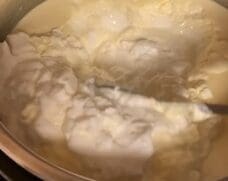
Raw milk is known for its rich and complex flavor profile. If your raw milk comes from Jersey milk cows, you can expect a higher ratio of butterfat (around 5%). Pasteurization reduces the presence of natural fats that give yogurt its creaminess.
If you like your yogurt thick, the proteins in raw milk produce a thicker and denser yogurt that’s more satisfying to the tastebuds.
Something cool about raw milk yogurt is that the overall flavor is influenced by factors such as the dairy cow’s diet, their breed, and the local environment. You can end up with a yogurt that has regional character.
What are the nutritional benefits of using raw milk in yogurt?
Raw milk retains its natural composition when you skip the pasteurization process. You can reap the nutritional benefits of raw milk if you’re comfortable skipping the heat treatment.
Some of the ways raw milk yogurt positively impacts your health include:
- Conjugated Linoleic Acid (CLA) is found in raw milk. The CLA content of the milk is higher with pasture-raised dairy cattle. CLA has many health advantages, including anti-inflammatory and anti-cancer properties.
- Higher nutrient absorption occurs in the presence of enzymes and other beneficial bacteria found in unpasteurized raw milk. Your body makes better use of the vitamins and minerals in their natural state.
- Omega-3 fatty acids are essential for brain and heart health and can be found in raw milk from grass-fed cows.
- Probiotics and beneficial bacteria found in raw milk promote a healthy balance of gut microbiota7, potentially offering digestive and immune system benefits.
A final word on raw milk yogurt
As you’ve probably guessed by now, we’re fans of not heating (pasteurization) raw milk before using it to make homemade yogurt.
You simply can’t beat the health benefits and the unique flavor of yogurt made from unheated raw milk. We understand you may be hesitant to give it a try. If there are any questions we can answer to help you in your decision, please feel free to put them in the comments and we’ll do our best to help you.
Can Heating Raw Milk Yogurt Affect Its Health Benefits?
Heating raw milk yogurt can potentially diminish its raw milk benefits respiratory infections. The beneficial bacteria and enzymes in raw milk may be destroyed during the heating process, reducing its ability to fight respiratory infections and provide other health benefits.
Sources
- About Raw Milk Nutrition. bcherdshare.org. Accessed November 21, 2023.
- Pasteurization. idfa.org. Accessed November 21, 2023.
- Alkaline Phosphatase (ALP) Testing for Milk Pasteurization. cals.cornell.edu. Accessed November 21, 2023.
- Leaky gut: What is it, and what does it mean for you? health.harvard.edu. Accessed November 21, 2023.
- Grade “A” Pasteurized Milk Ordinance. fda.gov. Accessed November 21, 2023.
- Role of lactic acid bacteria on the yogurt flavor: A review. tandfonline.com. Accessed November 21, 2023.
- Role of the gut microbiota in nutrition and health. bmj.com. Accessed November 21, 2023.
In our kitchen, we only use cultures from Cultures for Health.
Get yours here and start culturing today.
Popular Articles
Newsletter
Get signed up to get latest updates and new information from the Jersey Milk Cow!
This site uses Akismet to reduce spam. Learn how your comment data is processed.

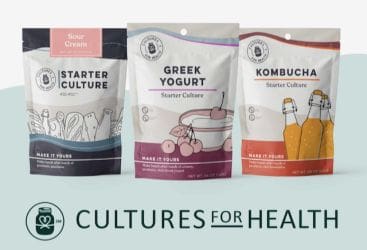
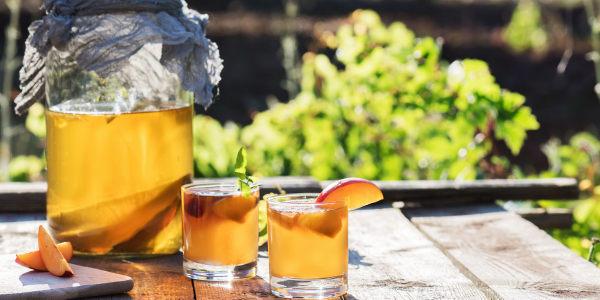





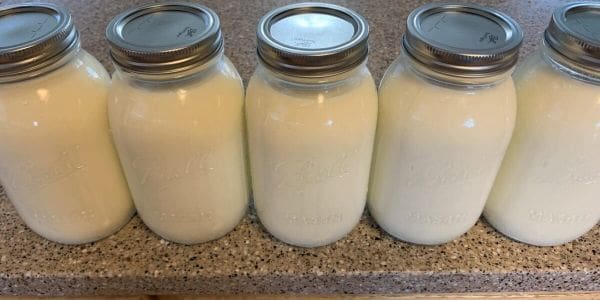
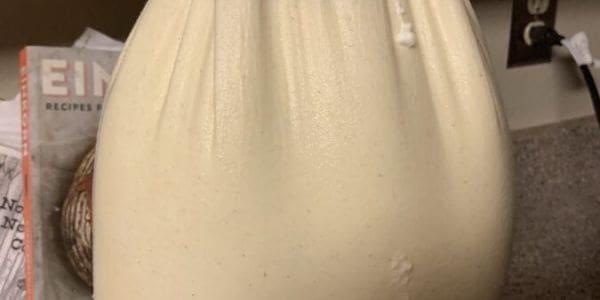


Leave a Reply